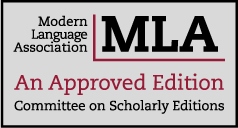The Ælfric Project
One might think, after centuries of attention, that the canon of Ælfric of Eynsham would be well established. The most erudite, prolific, and influential author writing in English before Chaucer, this tenth-century monk produced works that would be copied at least through the thirteenth century, read long after Old English might be dismissed as a dead language, and revived in the Renaissance to provide precedent for Anglican theology. From the Early Modern period, moreover, scholars have studied his writings, identified his sources, traced his impact on later authors, and otherwise sought to bring clarity to his literature and life. While extensive work has certainly been done on Ælfric’s complex corpus, however, with the majority of his homilies now published in volumes by the Early English Text Society, changes both in digital technology and editorial philosophy are allowing us to reassess Ælfric’s canon both on its fringes and at its heart. The Ælfric Project, though providing but small steps to this end, seeks to offer new lenses on Ælfric’s writings in two ways, through The Digital Ælfric and A Word for All Seasons.
The Digital Ælfric, first of all, is the resource at hand: a dynamic edition of a core section of arguably Ælfric’s most influential work, his Catholic Homilies. Rather than publishing once for all definitive versions of these homilies, Ælfric revised the collection in at least six main phases, producing multiple authorial originals. Individual pieces, moreover, he rewrote and redistributed in various forms over the course of his career. Similarly, after his death, rather than copying them verbatim as per Ælfric’s wish, scribes broke up his collections, extracted excerpts, and combined them with others’ writings to form new compilations. The Digital Ælfric examines a core set of eight homilies from the First Series of Catholic Homilies for the period from Easter to Pentecost—the only homilies with surviving manuscript witnesses to all known stages of authorial revision—tracing their development through Ælfric’s lifetime and nearly 200 years of transmission thereafter: twenty-four strands of textual tradition from twenty-seven manuscripts produced in at least five scriptoria through the early thirteenth century.
It is worth underscoring the potential implications of this shift in editorial philosophy for modern scholarship. Ælfric’s tendency to tinker with his texts challenges us to reconceptualize them as fluid rather than fixed. Traditional, static editions that seek to reproduce the “best” version of a homily, providing an amalgamation of the evidence or taking a snapshot at a point in history, offer a valuable form for study, making it easier for one to observe (say) that “Ælfric’s homily for the Ascension says X.” Like a pinned entomological specimen rather than a living creature, however, they do so at a cost. Digital technology offers scholars more than a convenient tool for tracking down variants for an apparatus; it allows us to begin to present a dynamic series of authorial originals, showing how texts changed not just in the mind of Ælfric, but in different centers and circumstances down through time. This new perspective, in turn, opens new avenues for investigation. Viewing a series of transcripts in parallel, how did a homily develop? Viewing a copy in the context of its manuscript, how might surrounding selections color a reader’s understanding? Viewing a manuscript in light of its original library’s holdings—perhaps at a time of intentional, programmatic acquisition—how might its Ælfrician offerings be read at that center at a particular moment in history? Alterations to these constantly changing texts may alert us to authorial and scribal habits of mind, shifting thematic concerns, and overarching didactic aims, leading users of The Digital Ælfric to raise questions about a discrete iteration of a homily in a particular manuscript at a specific moment in time.
A notable opportunity for this sort of work among the homilies edited here is Ælfric’s sermon for the Second Sunday after Easter (CH I.17), which he extensively revised late in his career to address the problem of greed among the English ruling class. Not only does The Digital Ælfric offer a singular opportunity to read the revised sermon in toto, but the electronic edition makes it possible to compare each version of the homily from the five manuscripts wherein it survives. Although a quick glance at the different texts reveals only slight substantive differences, a closer look at their manuscript contexts shows that two of the five codices date from the beginning of the twelfth century, about 100 years after Ælfric initially revised the sermon. Of course, even far removed from the circumstances that provoked him to revise it, a homily on greed has a certain timelessness given the fact that avaricious people in the twelfth century created the same social problems, faced the same spiritual dangers, and required the same moral and practical remedies as those in the tenth and eleventh. While the revision may have needed no adapting because the social and soteriological issues never changed, The Digital Ælfric prompts users to consider further the homiletic contexts in which the sermon was transmitted in the two late manuscripts. The revision was not adapted in either codex, but in one manuscript (Cambridge, Corpus Christi College 302) it accompanies two other widely-circulated and thus very popular castigations of greed, Ælfric’s Second Series sermon for the First Sunday in Lent and the anonymous Vercelli Homily X, the latter of which occurs twice in different versions to be delivered on different days. Add to this set of homilies four other Ælfrician sermons that deal in part with matters of wealth (a total of three of which occur in our Easter sequence, CH I.17–19), and suddenly a thematic through-line appears. Within a span of about five months, an audience would have heard eight sermons that touch on the moral matter of excessive wealth, three of which were fully devoted to the topic and made their target audience patently clear and their collective messages to the very wealthy inescapably pointed. Localize the preaching of these sermons to Canterbury or Rochester, the episcopal sees where the manuscript was likely produced, and we can begin to imagine scenarios in which the rich and powerful—ealdormen and royal and local thegns who attended shire courts or royal councils—must have occasionally found themselves within earshot of the powerful prelates of their day. With a trajectory from texts to social contexts in mind, the multiplicity and individuality of the sermons presented in The Digital Ælfric may open new windows onto the pastoral, religious, and political practices of Anglo-Saxon and post-Conquest England.
If the philosophy of The Digital Ælfric reassesses Ælfric’s canon at its heart, that of A Word for All Seasons looks afresh upon its fringes. While the majority of Ælfric’s homilies are accessible now in volumes published by the Early English Text Society, a number remain unpublished or scattered throughout incomplete nineteenth- or early-twentieth-century editions. The forthcoming Word for All Seasons will include all homilies not in Clemoes, Godden, Pope, and Irvine, along with a few associated items. Print, not digital, and more traditional in approach, it will offer a semi-diplomatic edition with modern punctuation, silently-expanded abbreviations, and standardized word-division; notes regarding manuscripts and sources; and commentary on such issues as theological and stylistic matters. More groundbreaking, however, will be its focus not simply on texts arguably known to be by Ælfric, but its consideration of works on the edges of Ælfric’s corpus: compilations composed entirely of excerpts from Ælfric, though perhaps not assembled by him, and anonymous amalgamations of material from Ælfric and other authors. While such “Ælfrician” writings may previously have been discounted as inauthentic (and while suggesting otherwise may have rendered Ælfric apoplectic), they are important witnesses to the posthumous development of Ælfric’s works—step-siblings that constitute later stages of a dynamic textual life. With such an expanded scope, A Word for All Seasons will seek to complement the editions of Clemoes, Godden, and Pope as a fundamental collection of Ælfrician homiletic material. Together with The Digital Ælfric, as part of the Ælfric Project, it will make these texts accessible to non-specialists while providing detailed analysis for scholars—promoting in the process a heightened appreciation for this pivotal figure of early English literature.
 Introduction
Introduction Image Library
Image Library